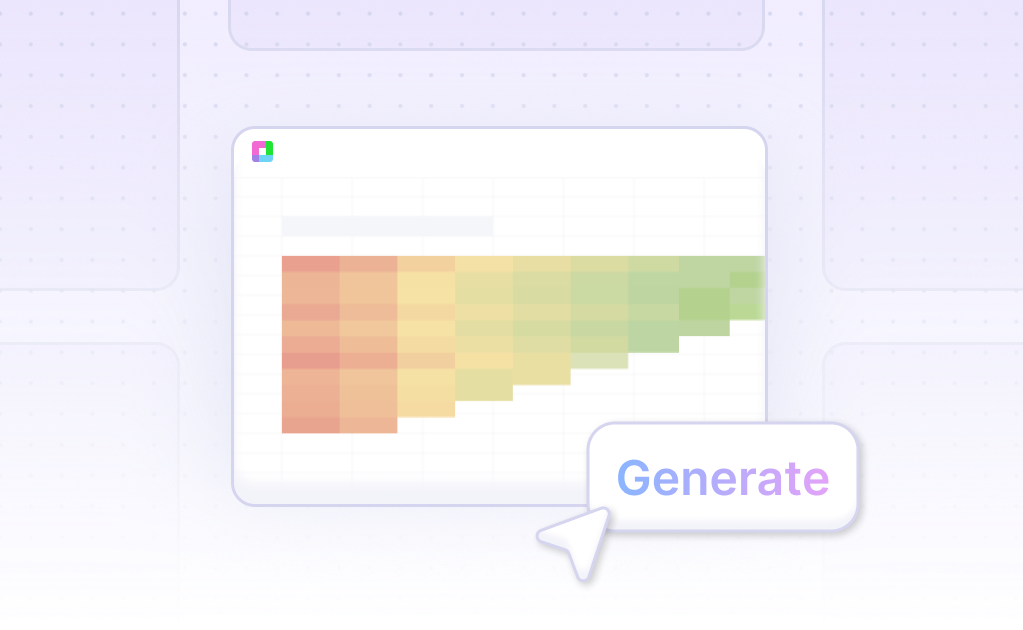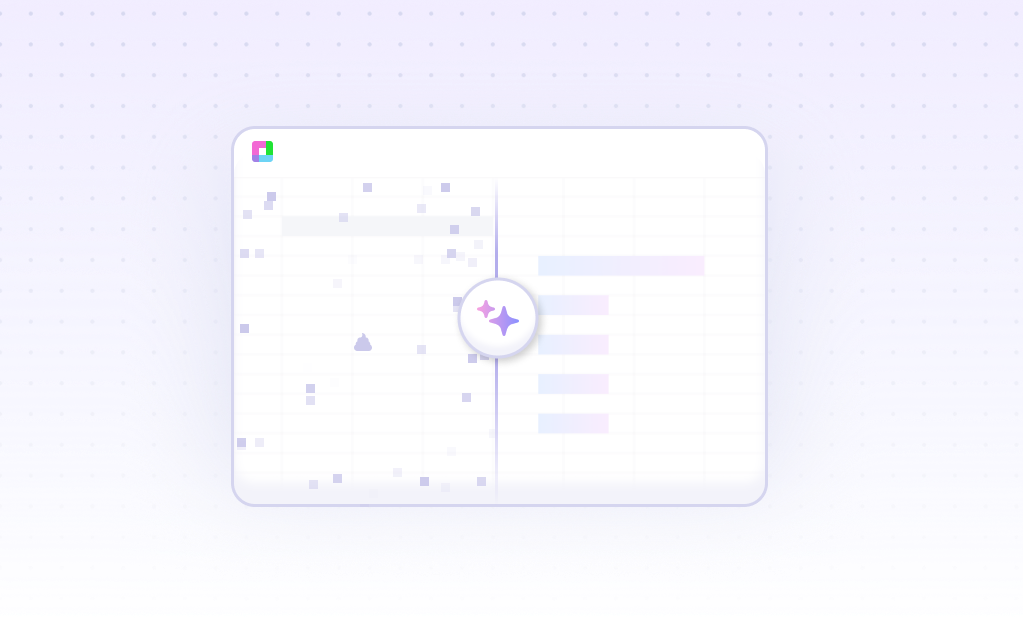
Introduction
A Stacked Area - Clustered Column Chart is useful for visualizing complex data sets by showing relationships and comparisons over time. Whether you are using AI technologies like Sourcetable or traditional spreadsheet programs such as Excel or Google Sheets, creating this type of chart can enhance your data analysis.
Sourcetable simplifies the process with its AI-powered spreadsheet assistant, enabling you to quickly generate detailed charts and graphs. This feature is especially beneficial for users who are not familiar with advanced spreadsheet functions, making it accessible for anyone to become a spreadsheet power user.
To start creating your Stacked Area - Clustered Column Chart with ease, sign up for Sourcetable here, or keep reading for more detailed instructions on how to use both AI-assisted and traditional methods.
What is a Stacked Area - Clustered Column Chart?
Definition and Components
The combined Stacked Area - Clustered Column Chart uses both stacked area charts and clustered column charts. The clustered column chart, a popular type in Excel, shows different series with separate column bars. In contrast, stacked column charts display different series by stacking them within a single column bar. The clustered and stacked column chart merges these approaches for detailed, comparative visualization.
Benefits
Stacked area charts visualize changes in measures over time through multiple category values. They effectively show contributions and cumulative totals from different categories. They also provide a rough estimate of values involved, tracking overall trends more effectively than individual values.
How to Create
Creating a Stacked Area - Clustered Column Chart involves rearranging the data layout, which can be done manually or using a pivot table and pivot chart. Excel also offers built-in chart types and add-ins for creating these charts. Adjusting the data layout by adding blank rows and rearranging data is essential before chart creation.
Examples
Common examples include: Quarterly Revenue by Division and Revenue from New Apps per Division. These examples illustrate how different divisions contribute to overall revenue over time.
Comparison with Other Chart Types
Column charts are excellent for showing changes, trends, and disparities over time, and for comparing individual values. Stacked column charts are more effective for showing subcategory comparisons and visualizing overall composition and trends.
When to Use a Stacked Area - Clustered Column Chart
Ideal Applications
Use a Stacked Area - Clustered Column Chart when you need to visualize both the overall totals and the distribution of categories within those totals. This type of chart is especially valuable for displaying data that changes over time, helping to highlight trends and comparisons simultaneously. It is effective for identifying cumulative effects and segmented relationships within datasets.
Pros of Stacked Area - Clustered Column Charts
These charts provide a dual perspective, combining the benefits of stacked area charts and clustered columns. They offer a clear view of individual category contributions and overall progressions. Stacked Area - Clustered Column Charts are visually engaging and can simplify complex data relationships for better understanding.
Cons of Stacked Area - Clustered Column Charts
A downside is potential clutter, which can make the chart hard to read if too many categories are included. The overlapping areas can sometimes lead to misinterpretation, as changes in individual segments might be less noticeable. They require careful design to maintain clarity.
Comparison with Other Charts
Compared to a simple column chart, the Stacked Area - Clustered Column Chart shows more detailed information, revealing both individual segments and their cumulative contributions. Unlike line charts, which focus on overall trends, this chart type provides insights into both trends and category distributions. While pie charts illustrate relative proportions, they lack the time dimension that Stacked Area - Clustered Column Charts offer. Choose your chart type based on the complexity and nature of your data to ensure the most effective visualization.
How to Generate a Stacked Area - Clustered Column Chart with Sourcetable
- Using Sourcetable's AI spreadsheet, generating a Stacked Area - Clustered Column Chart has never been easier. This chart combines the visual benefits of both stacked area and clustered column charts. Follow these steps for a seamless experience.
- First, create sample data using Sourcetable's AI assistant or upload a CSV file. This step ensures you have relevant data to work with. The AI assistant makes it simple to generate high-quality data quickly.
- Next, select the range of data you want to visualize as a Stacked Area - Clustered Column Chart. Highlight the cells containing your data to prepare it for chart generation.
- Then, ask the AI assistant to generate the Stacked Area - Clustered Column Chart. This step transforms your selected data into the desired visual format. The AI handles all the complex calculations and formatting.
- Finally, use the AI assistant to refine or iterate on the Stacked Area - Clustered Column Chart. Specify any changes to formatting, labels, or other elements to perfect your chart. This iterative process allows for customization and fine-tuning.
- In the next section, we will show how to generate a Stacked Area - Clustered Column Chart manually in tools like Excel or Google Sheets. Follow along to learn more traditional methods, if you prefer.
How to Generate a Stacked Area - Clustered Column Chart in Excel and Google Sheets
Creating a Stacked Area - Clustered Column Chart in Excel
To create a clustered stacked column chart in Excel, first rearrange the data layout. Organize the data in a summary grid that includes multiple years, seasons, and regions. Place the regions in the rows and the years and seasons in the columns. Sales amounts should fill the grid for each region, season, and year.
After modifying the data layout, create a chart from this revised data. Use sample files like the Cluster Stack Chart and Win and Loss Chart to understand original and rearranged data layouts. These files also show completed charts for reference.
You may also use pivot tables and pivot charts to visualize sales data in different clustered stack layouts. Adjust the chart's gap width and colors to finalize the design.
Creating a Stacked Area - Clustered Column Chart in Google Sheets
To generate a clustered column chart in Google Sheets, start by selecting the desired data. Click on the Insert menu, then select Chart. Google Sheets usually recommends a chart type based on the selected data.
In the Chart Editor panel that appears on the right side of the worksheet, change the chart type to Column Chart. The chart will then update on the worksheet to reflect this choice.
Comparing Data Sets with Clustered Column Charts
Clustered column charts are useful for directly comparing multiple data sets displayed in vertical columns. They help find trends over time and show part-to-whole relationships without emphasizing the cumulative total.
Whether using Excel or Google Sheets, following these steps ensures you can create informative and visually appealing stacked area - clustered column charts to analyze and present complex data effectively.
Use Cases of Visualizing Data Using a Stacked Area - Clustered Column Chart
Trend Analysis |
Visualizing data with a Stacked Area - Clustered Column Chart enables users to analyze trends over time. The chart helps to clearly distinguish differences in data series, facilitating better historical data analysis and future trend predictions. |
Market Segmentation |
Businesses can use this chart to segment markets more effectively. By visualizing market data clustered by different categories, companies can identify which segments are growing and which need attention, optimizing their marketing strategies. |
Resource Allocation |
The chart aids in effective resource allocation by showcasing how different resources contribute to the overall performance. Companies can make informed decisions on reallocating resources based on which segments are performing well. |
Sales Performance Comparison |
Sales teams can compare performance across various products or regions. The combined visualization helps identify strong and weak areas, driving strategic decisions to improve overall sales performance. |
Financial Forecasting |
Financial analysts use this chart to forecast revenue and expenses. The distinction between different sources of income and expenditure helps in creating more accurate financial projections and strategic plans. |
Project Management |
Project managers can track progress across various phases or components of a project. The visualization offers a clear representation of how different tasks contribute to the project timeline and completion status. |
Frequently Asked Questions
How can I combine clustered and stacked column charts in Excel?
Combining clustered and stacked column charts in Excel is complex and requires additional actions and preparations. Using secondary axes can simplify the process.
Why do users find it confusing to combine clustered and stacked column charts?
The combination of clustered and stacked column charts involves multiple steps and additional work, which can confuse users.
What are stacked charts used for?
Stacked charts show the ratio between a total and its parts by displaying different series as part of the same single column bar.
What is the most comprehensible method for combining clustered and stacked column charts?
The most comprehensible method for combining these charts is using multiple secondary axes, which are easy to set up.
What are some best practices for using a stacked area chart?
Maintain a zero-baseline, order categories from largest to smallest, place sub-bars in the same order for each bar, and use a color palette that matches the variable type.
Conclusion
In our guide, we explored the Stacked Area - Clustered Column Chart, detailing its definition and its analytic applications. We demonstrated how AI in Sourcetable simplifies creating these complex charts by using the in-built AI spreadsheet assistant. For users preferring traditional methods, steps to generate this chart using spreadsheet programs like Excel or Google Sheets were also outlined.
Whether you are a seasoned data analyst or a business enthusiast, leveraging the power of AI with Sourcetable can enhance your data visualization capabilities significantly. Take the leap towards smarter spreadsheet management and more insightful data analysis.
Ready to create your first Stacked Area - Clustered Column Chart with ease? Sign up for Sourcetable today and discover the power of AI in spreadsheet management.
Recommended Guides
Connect your most-used data sources and tools to Sourcetable for seamless analysis.
अक्सर पूछे जाने वाले प्रश्न
यदि आपका प्रश्न यहाँ कवर नहीं किया गया है, तो आप हमारी टीम से संपर्क कर सकते हैं।
हमसे संपर्क करें




